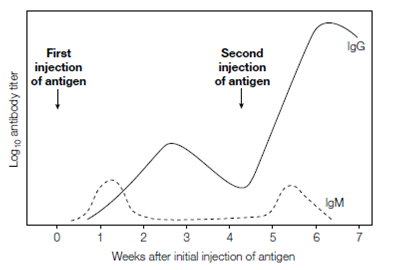Primary and secondary immune responses
The presence of a foreign antigen stimulates the production of a exact antibody in the bloodstream which will recognize and bind tightly to it. Antibody molecules fall into 5 major classes their responses as described through their precise structure. The antibody molecules first produced after antigen injection are in the immunoglobulin M class and so are called IgM molecules. Moreover about 10 days after antigen injection the amount of IgM in the blood- stream the titer of antibody declines and there is a concurrent increase in another class of antibody known as immunoglobulin G (IgG) which is described in Figure. This is called the primary immune response.
One of the very important features of the immune system is that, the system confers protection once an animal has encountered a particular pathogen, against future infection.

Figure: The primary and secondary immune responses to injections of antigen.
This immunological memory denote that if the similar antigen or pathogen is encountered a second time possibly even decades after the past occurrence then the system reacts much faster and more dramatically to produce a huge titer of specific IgG to counter the antigen. This is the secondary immune response and is mediated through long-lived memory B cells and memory T cells.